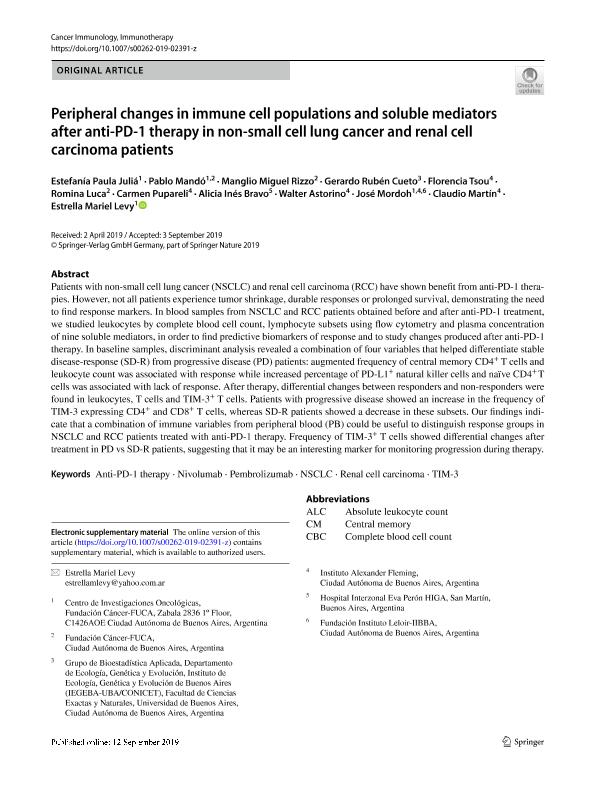Artículo
Peripheral changes in immune cell populations and soluble mediators after anti-PD-1 therapy in non-small cell lung cancer and renal cell carcinoma patients
Juliá, Estefanía Paula ; Mandó, Pablo; Rizzo, Manglio Miguel
; Mandó, Pablo; Rizzo, Manglio Miguel ; Cueto, Gerardo Ruben
; Cueto, Gerardo Ruben ; Tsou, Florencia; Luca, Romina; Pupareli, Carmen; Bravo, Alicia Inés; Astorino, Walter; Mordoh, José; Martín, Claudio; Levy, Estrella Mariel
; Tsou, Florencia; Luca, Romina; Pupareli, Carmen; Bravo, Alicia Inés; Astorino, Walter; Mordoh, José; Martín, Claudio; Levy, Estrella Mariel
 ; Mandó, Pablo; Rizzo, Manglio Miguel
; Mandó, Pablo; Rizzo, Manglio Miguel ; Cueto, Gerardo Ruben
; Cueto, Gerardo Ruben ; Tsou, Florencia; Luca, Romina; Pupareli, Carmen; Bravo, Alicia Inés; Astorino, Walter; Mordoh, José; Martín, Claudio; Levy, Estrella Mariel
; Tsou, Florencia; Luca, Romina; Pupareli, Carmen; Bravo, Alicia Inés; Astorino, Walter; Mordoh, José; Martín, Claudio; Levy, Estrella Mariel
Fecha de publicación:
10/2019
Editorial:
Springer
Revista:
Cancer Immunology Immunotherapy
ISSN:
0340-7004
Idioma:
Inglés
Tipo de recurso:
Artículo publicado
Clasificación temática:
Resumen
Patients with non-small cell lung cancer (NSCLC) and renal cell carcinoma (RCC) have shown benefit from anti-PD-1 therapies. However, not all patients experience tumor shrinkage, durable responses or prolonged survival, demonstrating the need to find response markers. In blood samples from NSCLC and RCC patients obtained before and after anti-PD-1 treatment, we studied leukocytes by complete blood cell count, lymphocyte subsets using flow cytometry and plasma concentration of nine soluble mediators, in order to find predictive biomarkers of response and to study changes produced after anti-PD-1 therapy. In baseline samples, discriminant analysis revealed a combination of four variables that helped differentiate stable disease-response (SD-R) from progressive disease (PD) patients: augmented frequency of central memory CD4+ T cells and leukocyte count was associated with response while increased percentage of PD-L1+ natural killer cells and naïve CD4+ T cells was associated with lack of response. After therapy, differential changes between responders and non-responders were found in leukocytes, T cells and TIM-3+ T cells. Patients with progressive disease showed an increase in the frequency of TIM-3 expressing CD4+ and CD8+ T cells, whereas SD-R patients showed a decrease in these subsets. Our findings indicate that a combination of immune variables from peripheral blood (PB) could be useful to distinguish response groups in NSCLC and RCC patients treated with anti-PD-1 therapy. Frequency of TIM-3+ T cells showed differential changes after treatment in PD vs SD-R patients, suggesting that it may be an interesting marker for monitoring progression during therapy.
Palabras clave:
ANTI-PD-1 THERAPY
,
NIVOLUMAB
,
NSCLC
,
PEMBROLIZUMAB
,
RENAL CELL CARCINOMA
,
TIM-3
Archivos asociados
Licencia
Identificadores
Colecciones
Articulos(IEGEBA)
Articulos de INSTITUTO DE ECOLOGIA, GENETICA Y EVOLUCION DE BS. AS
Articulos de INSTITUTO DE ECOLOGIA, GENETICA Y EVOLUCION DE BS. AS
Citación
Juliá, Estefanía Paula; Mandó, Pablo; Rizzo, Manglio Miguel; Cueto, Gerardo Ruben; Tsou, Florencia; et al.; Peripheral changes in immune cell populations and soluble mediators after anti-PD-1 therapy in non-small cell lung cancer and renal cell carcinoma patients; Springer; Cancer Immunology Immunotherapy; 68; 10; 10-2019; 1585-1596
Compartir
Altmétricas



